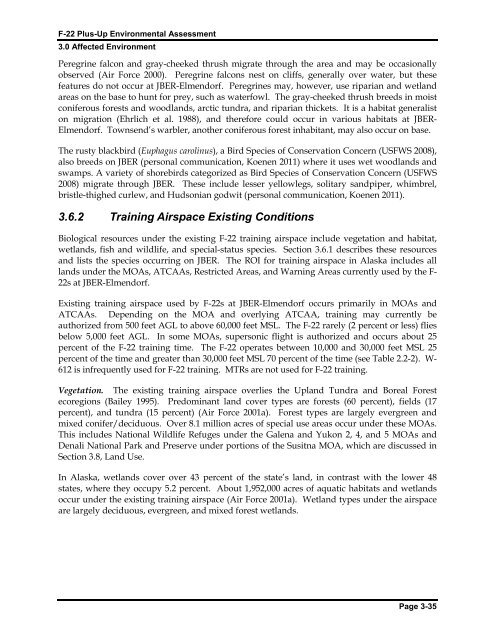F-22 Plus-Up Environmental Assessment - Joint Base Elmendorf ...
F-22 Plus-Up Environmental Assessment - Joint Base Elmendorf ...
F-22 Plus-Up Environmental Assessment - Joint Base Elmendorf ...
You also want an ePaper? Increase the reach of your titles
YUMPU automatically turns print PDFs into web optimized ePapers that Google loves.
F-<strong>22</strong> <strong>Plus</strong>-<strong>Up</strong> <strong>Environmental</strong> <strong>Assessment</strong><br />
3.0 Affected Environment<br />
Peregrine falcon and gray-cheeked thrush migrate through the area and may be occasionally<br />
observed (Air Force 2000). Peregrine falcons nest on cliffs, generally over water, but these<br />
features do not occur at JBER-<strong>Elmendorf</strong>. Peregrines may, however, use riparian and wetland<br />
areas on the base to hunt for prey, such as waterfowl. The gray-cheeked thrush breeds in moist<br />
coniferous forests and woodlands, arctic tundra, and riparian thickets. It is a habitat generalist<br />
on migration (Ehrlich et al. 1988), and therefore could occur in various habitats at JBER-<br />
<strong>Elmendorf</strong>. Townsend’s warbler, another coniferous forest inhabitant, may also occur on base.<br />
The rusty blackbird (Euphagus carolinus), a Bird Species of Conservation Concern (USFWS 2008),<br />
also breeds on JBER (personal communication, Koenen 2011) where it uses wet woodlands and<br />
swamps. A variety of shorebirds categorized as Bird Species of Conservation Concern (USFWS<br />
2008) migrate through JBER. These include lesser yellowlegs, solitary sandpiper, whimbrel,<br />
bristle-thighed curlew, and Hudsonian godwit (personal communication, Koenen 2011).<br />
3.6.2 Training Airspace Existing Conditions<br />
Biological resources under the existing F-<strong>22</strong> training airspace include vegetation and habitat,<br />
wetlands, fish and wildlife, and special-status species. Section 3.6.1 describes these resources<br />
and lists the species occurring on JBER. The ROI for training airspace in Alaska includes all<br />
lands under the MOAs, ATCAAs, Restricted Areas, and Warning Areas currently used by the F-<br />
<strong>22</strong>s at JBER-<strong>Elmendorf</strong>.<br />
Existing training airspace used by F-<strong>22</strong>s at JBER-<strong>Elmendorf</strong> occurs primarily in MOAs and<br />
ATCAAs. Depending on the MOA and overlying ATCAA, training may currently be<br />
authorized from 500 feet AGL to above 60,000 feet MSL. The F-<strong>22</strong> rarely (2 percent or less) flies<br />
below 5,000 feet AGL. In some MOAs, supersonic flight is authorized and occurs about 25<br />
percent of the F-<strong>22</strong> training time. The F-<strong>22</strong> operates between 10,000 and 30,000 feet MSL 25<br />
percent of the time and greater than 30,000 feet MSL 70 percent of the time (see Table 2.2-2). W-<br />
612 is infrequently used for F-<strong>22</strong> training. MTRs are not used for F-<strong>22</strong> training.<br />
Vegetation. The existing training airspace overlies the <strong>Up</strong>land Tundra and Boreal Forest<br />
ecoregions (Bailey 1995). Predominant land cover types are forests (60 percent), fields (17<br />
percent), and tundra (15 percent) (Air Force 2001a). Forest types are largely evergreen and<br />
mixed conifer/deciduous. Over 8.1 million acres of special use areas occur under these MOAs.<br />
This includes National Wildlife Refuges under the Galena and Yukon 2, 4, and 5 MOAs and<br />
Denali National Park and Preserve under portions of the Susitna MOA, which are discussed in<br />
Section 3.8, Land Use.<br />
In Alaska, wetlands cover over 43 percent of the state’s land, in contrast with the lower 48<br />
states, where they occupy 5.2 percent. About 1,952,000 acres of aquatic habitats and wetlands<br />
occur under the existing training airspace (Air Force 2001a). Wetland types under the airspace<br />
are largely deciduous, evergreen, and mixed forest wetlands.<br />
Page 3-35
















